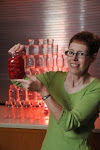Easter Egg Safety
If you plan to eat the Easter eggs you decorate be sure to use only food grade dye. Some people make two sets of eggs – one for decorating and then hiding and another set for eating. Others use plastic eggs for hiding.
For an Easter egg hunt, void cracking the egg shells. If the shells crack, bacteria could contaminate the egg in inside. Hide eggs in places that are protected from dirt, pets, and other bacteria sources. Keep hard-cooked eggs chilled in the refrigerator until just before the hunt.
The total time for hiding and hunting eggs should be no more than two hours. Be sure to refrigerate the “found” eggs right away until you eat them. Eggs found hours later or the next day should be thrown out.
Eggs play an important role on the Seder plate during Passover celebrations. If that egg sits out at room temperature for more than two hours then it should not be eaten. Since the hard-cooked eggs that are usually served to each person as part of the special dinner are meant to be eaten, keep those eggs in the refrigerator until ready to be served.
When shell eggs are hard-cooked, the protective coating is washed away, leaving open pores in the shell where harmful bacteria can enter. Be sure to refrigerate eggs within two hours of cooking and use them within a week. Check your refrigerator temperature with an appliance thermometer and adjust the refrigerator temperature to 40 degrees or below.
Source: USDA Food Safety and Inspection Website





No comments:
Post a Comment